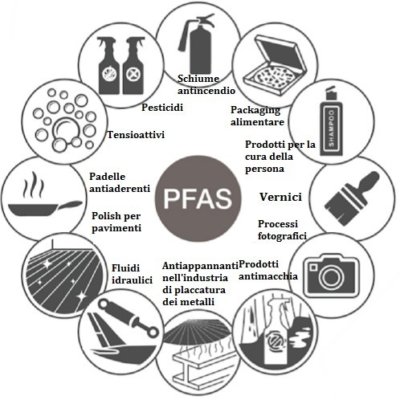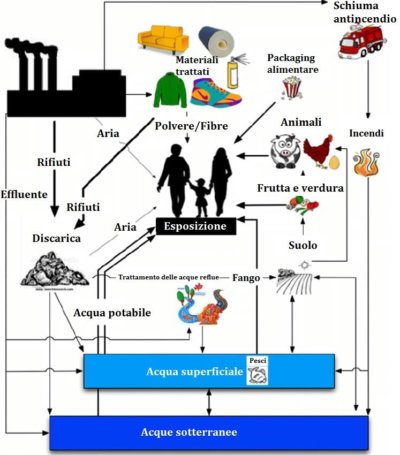DISCOVERING PFAS
WHAT ARE PFAS?
PFAS is an acronym that stands for Per/Poli Fluoro Alkyl Substances: it is a family of chemical compounds produced by man and not naturally present in the environment mainly used in the industrial field.
PFAS are organic molecules containing fluorine; they have a chemical structure that gives them very significant properties, and this is the reason why they are used to obtain excellent results in various industrial sectors, including the automotive. The main features are:
- Hydro and oil repellency
- Chemical resistance
- Wear and corrosion resistance
- Thermal resistance
WHERE ARE THEY USED?
Thanks to their characteristics, PFAS are used in different industrial and consumer sectors to make surfaces water- and oil-repellent and resistant to heat and wear: they can be found, for example, in fabrics, leather, carpets and clothings, paper coatings for food and non-stick cookware. The most commercially known material containing PFAS is Teflon(PTFE): this is used both to cover pans and in water-repellent and breathable fabrics such as Gore-tex and for the construction of waterproofing elements in the construction sector.
PFAS are also used in the car care sector: waxes, polishes and PFAS-based coatings can be found on the market that promise good wear resistance and body protection by creating an antistatic protective film that repels smog and dirt, thus allowing the paint to remain clean and protected.
Due to their environmental persistence and their ability to accumulate in organisms, some manufacturers are focusing to reduce the usage of PFOA and PFOS and to replace them with shorter-chain PFAS(6 or 4 carbon atoms), which have a reduced persistence, measurable in a few days.
The ambitious goal of the industry over the next few years is to totally eliminate the use of PFAS and to find alternative substances in order to achieve greater protection of the environment and health, even if the task is not easy in terms of both performances and costs. The last update of the REACh Regulation prohibits the production and the placing on the market of PFOA in all production sectors by 4th July 2023. PFOS and its derivatives are classified by Reg. (EC) No. 850/2004 as persistent organic pollutants (POPs), and therefore they are already subject to prohibition or severe limitations.

EXPOSURE METHODS
PFAS waste is disposed of around the production plant and in local landfills. PFAS are highly volatile substances which can persist in the air for days and can be transported before falling on the ground; here they move easily through underground lands where they can travel long distances and contaminate groundwater and surface water, including local drinking water wells: pollution is therefore dispersed and not confined near the production sites.
The main sources of exposure to PFAS are:
- processing of PFAS and products containing them
- ingestion of contaminated drinking water or foods (such as fish products, fruits and meat)
- inhalation of dust containing traces of these substances deriving from the treated surfaces, such as carpets, clothes and shoes; moreover, at the time of opening the containers of PFAS-based products, part of these is breathed due to their volatility
- the passage through skin: the absorption of PFAS, pure or dissolved in water, also occurs through the skin, therefore contact with products in the detailing sector can constitute a source of contamination by PFAS.
Exposure to PFAS is also due to the degradation of materials; the most striking example is the loss of water repellency of fabrics or bodycar: the decrease in water repellency implies the disappearance of PFAS from surfaces and their diffusion into the air.
As they are not biodegradable, PFAS have been the subject of many environmental studies: PFOS has a half-life in the environment of 41 years, while PFOA has a half-life in the environment of 8 years; this means that they have a high potential for bioaccumulation and biomagnification.

EFFECTS ON HEALTH
There are high levels of PFAS in the blood of consumers and workers because these molecules are not destroyed by the body or by the sun. Since PFAS bind to plasma proteins and are not metabolized by the body, they accumulate in the liver and to a lesser extent in the kidneys; their elimination is very slow, because once filtered in the urine they undergo a process of reabsorption which brings them back into circulation. The half-life, which is the time required for blood levels to be reduced to half, is on average 5.4 years for PFOS and 3.8 years for PFOA, with gender differences: in men half-lives are longer than in women.
Epidemological studies have shown the association of PFOA with various diseases:
- High cholesterol, which causes an increased risk of arteriosclerosis
- Ulcerative colitis
- Thyroid dysfunction
- Gestational hypertension
- Male reproductive system dysfunction: in particular PFOS and PFOA influence sperm parameters and affect the action of sex hormones, such as testosterone
- Increased uric acid value, which is a risk factor for gout and kidney stones
PFOS and in particular PFOA have been subject to evaluation by IARC (International Agency for Research on Cancer) and US EPA (USA Environmental Protection Agency) for their carcinogenic potential and in 2017 IARC classified PFOA as “possibly associated” (group 2B) to kidney and testicular tumors.
As PFAS are responsible for alterations in metabolism and determine certain risk conditions that can lead to an increase in chronic diseases, the exposure to these substances could be considered the fifth risk factor for chronic non-communicable diseases:
- Smoke
- Use of alcohol
- Incorrect feeding
- Physical inactivity
- Exposure to PFAS
For further details:
- “Perfluoroalkylated substances: PFOS and PFOA” of the Ministry of Health
- “Implementation of a study to assess the Environmental and Health Risk associated with the contamination by perfluoro-alkylated substances (PFAS) in the Po River Basin and in the main Italian river basins”of the Ministry of the Environment

